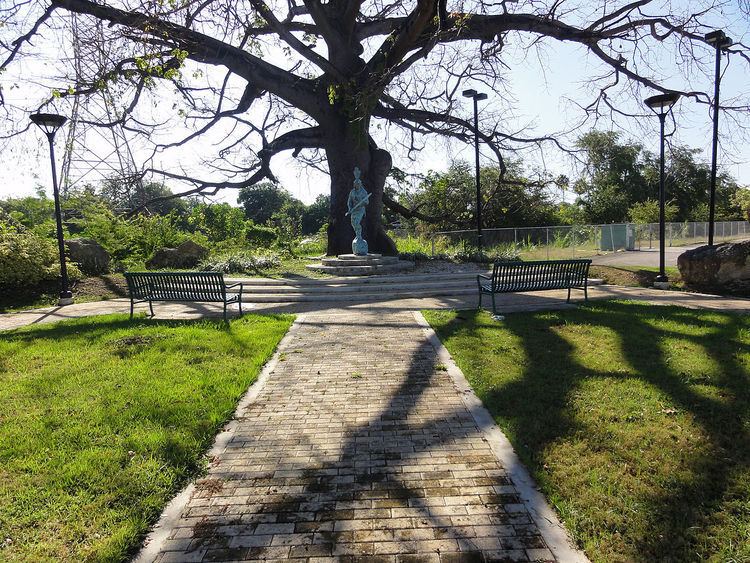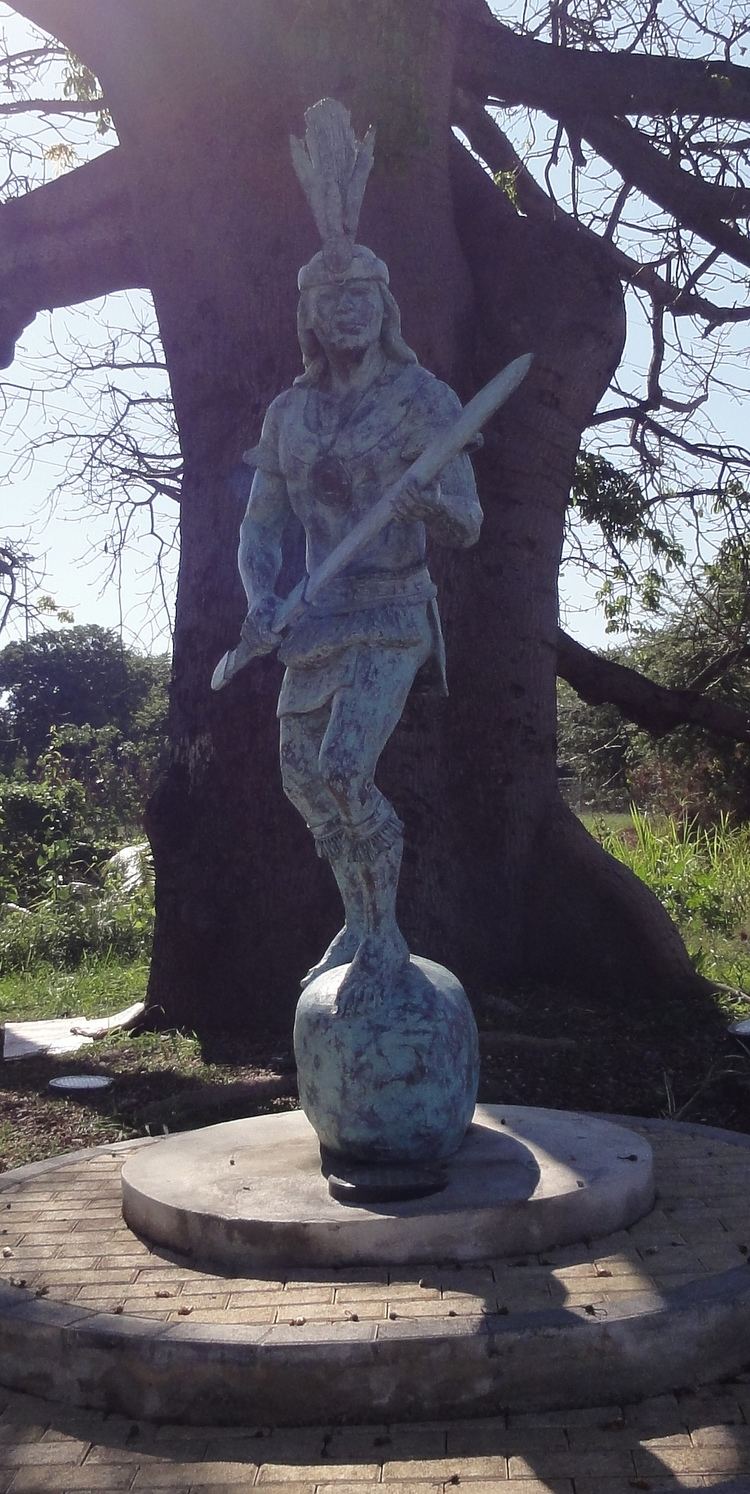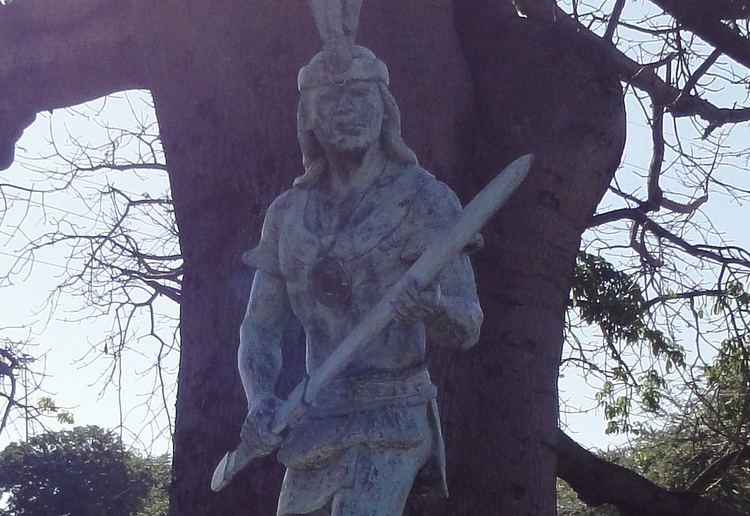Name Agueybana II Siblings Agueybana I Relations Brother of Agueybana | Role Agueybana I's brother | |
 | ||
Battles/wars Taino rebellion of 1511 | ||
Nickname(s) "El Bravo" (The Brave) Commands held Tainos of "Boriken" Battles and wars Taino rebellion of 1511 | ||
Agüeybaná II (c. 1470 – 1511), born Güeybaná and also known as Agüeybaná El Bravo (English: Agüeybaná The Brave), was one of the two principal and most powerful caciques of the Taíno people in "Borikén" when the Spaniards first arrived in Puerto Rico on November 19, 1493. Agüeybaná II led the Taínos of Puerto Rico in the Battle of Yagüecas, also known as the "Taíno rebellion of 1511" against Juan Ponce de León and the Spanish Conquistadors.
Contents
- Etimology
- Arrival of the Conquistadors
- Tano rebellion of 1511
- Death
- Aftermath of the battle
- Legacy
- References

Etimology

Agüeybana, which has been interpreted by 19th and 20th-century authors as meaning "The Great Sun", was the hereditary title shared by the family that ruled the theocratic monarchy of Borikén, governing the hierarchy over the rest of the regional chiefs or caciques. Like other nobiliary recognitions within Taíno culture, it was passed down through the maternal bloodline. The Spanish Hispanicized the title to be the equivalent of the European concept of kings, with contemporary writers such as Juan de Castellanos employing the title of Rey Agüeybana (literally meaning "King Agüeybana") when referring to him after inheriting it from his brother and becoming the second monarch to lead the Taíno during the 1510s.
Arrival of the Conquistadors
Agüeybaná, the older, received Spanish conquistador Juan Ponce de León upon Ponce de León's arrival to Puerto Rico in 1508. According to an old Taíno tradition, Agüeybaná practiced the "guaytiao", a Taíno ritual in which he and Juan Ponce de León became friends and exchanged names. The hospitality and friendly treatment that the Spaniards received from Agüeybaná made it easy for the Spaniards to betray and conquer the island later. Agüeybaná's actions helped to maintain the peace between the Taíno and the Spaniards, a peace which was to be short-lived.
Taíno rebellion of 1511
Upon the senior Agüeybaná's death in 1510, his brother Güeybaná (better known as Agüeybaná II) became the most powerful Cacique in the entire island. Agüeybaná II had his doubts about the "godly" status of the Spaniards. He came up with a plan to test the perceived godly nature of the Spanish: he and Urayoán (cacique of Añasco) sent some of their tribe members to lure a Spaniard by the name of Diego Salcedo into a river and drown him. They watched over Salcedo's body to make sure that he would not resuscitate. Salcedo's death was enough to convince him and the rest of the Taíno people that the Spaniards were not gods.
Agüeybaná II, held Areytos (war dances) or secret meetings with others caciques where he organized a revolt against the Spaniards. Cristobal de Sotomayor sent a spy, Juan González, to one of the Areitos where he learned of Agüeybaná's plans. In spite of the warning, Agüeybana II killed Sotomayor and his men, and gravely wounded González. Juan González escaped making his way to Caparra where he reported the killings to Ponce de León. Meanwhile, Guarionex, cacique of Utuado, attacked the village of Sotomayor (present day Aguada) and killed eighty of its inhabitants. After this, Ponce de León led the Spaniards in a series of offensives against the Tainos that culminated in the Battle of Yagüecas.
Death
In 1511, in the region known as Yagüecas some 11,000 to 15,000 Taínos had assembled against some 80 to 100 Spaniards. Before the start of the battle, a Spanish soldier using an arquebus shot and killed a native. It is presumed this was Agüeybaná II, because the warrior was wearing a golden necklace which only a cacique wore.
Aftermath of the battle
After the death of Agüeybaná II, the native warriors retracted and became disorganized. Agüeybaná II's followers opted for engaging the Spaniards via guerilla tactics. Such guerilla warfare rebellion lasted for next 8 years, until 1519. A second round of raids erupted in 1513 when Ponce de Leon departed the island to explore Florida. The settlement of Caparra, the seat of the island government at that time, was sacked and burned by an alliance between Taínos and natives from the northeastern Antilles.
By 1520 the Taíno presence in the Island had almost disappeared. A government census in 1530 reports the existence of only 1,148 Taínos remaining in Puerto Rico. However, oppressive conditions for the surviving Taíno continued. Many of those who stayed on the island soon died of either the cruel treatment that they had received or of the smallpox epidemic, which had attacked the island in 1519.
Legacy
Agüeybaná II is admired in Puerto Rico for his loyalty to his people. Puerto Rico has named many public buildings and streets after him:
